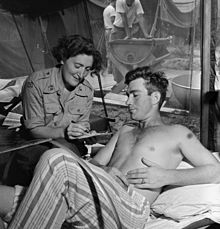
Syngman Rhee was a South Korean politician who served as the first president of South Korea from 1948 to 1960. Rhee is also known by his art name Unam. Rhee was also the first and last president of the Provisional Government of the Republic of Korea from 1919 to his impeachment in 1925 and from 1947 to 1948. As president of South Korea, Rhee's government was characterised by authoritarianism, limited economic development, and in the late 1950s growing political instability and public opposition.
This is the Korean War order of battle. Subsidiary commands are listed on sub-pages. Where no date is shown for a command, assume it present at the start of the war, on June 25, 1950.

The Eighth Army is a U.S. field army which commands all United States Army forces in South Korea. It is headquartered at the Camp Humphreys in the Anjeong-ri of Pyeongtaek, South Korea. Eighth Army relocated its headquarters from Yongsan to Camp Humphreys in the summer of 2017. It is the only field army in the U.S. Army. It is responsible to United States Forces Korea and United States Army, Pacific.

The Regiment van Heutsz is a line infantry regiment of the Royal Netherlands Army. The regiment was named after J.B. van Heutsz, a former Governor-General of the Dutch East Indies who successfully brought the Aceh War closer to an end, and was formed on July 1, 1950. It is notable for its service as part of the United Nations force sent to fight during the Korean War. It is still operational and has served tours as part of the ISAF Afghanistan mission.

MS Jutlandia was contracted by and built for the East Asiatic Company (EAC) in 1934, as a combined passenger and cargo ship at EAC's Nakskov Shipyard, Denmark. Following an extended operational life in which she also served as a hospital ship and a royal yacht, she was finally decommissioned in 1965.
The Presidential Unit Citation is a military unit award of the government of Republic of Korea that may be presented to South Korean military units and foreign military units for outstanding performance in defense of the Republic of Korea. In recognition of allied military service to South Korea during the Korean War, all United States military departments were authorized the unit award for that period.

United Nations Command is the multinational military force established to support the Republic of Korea during and after the Korean War. It was the first international unified command in history, and the first attempt at collective security pursuant to the Charter of the United Nations.
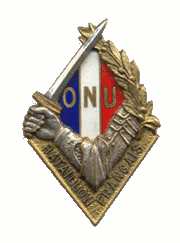
The French Battalion of the United Nations Organisation was a battalion of volunteers made up of active and reserve French military personnel sent to the Korean Peninsula as part of the UN force fighting in the Korean War.
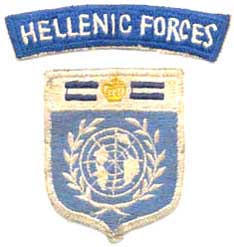
The Greek Expeditionary Force (GEF) in Korea was formed in response to the United Nations appeal for assistance in the Korean War. It comprised a reinforced Hellenic Army (HA) infantry battalion and the Royal Hellenic Air Force (RHAF) 13th flight of seven transport planes (C-47). Greece originally intended to send a brigade to Korea; upon consultation with the US, however, the expeditionary force was downgraded to a battalion attached to the US 1st Cavalry Division. The 13th Flight supported the US marine division and played an important role of evacuating the dead and the wounded. After the armistice, the RHAF unit withdrew in May 1955 and the HA unit in December 1955. Greece was the fifth largest troop contributor to U.N. Forces in Korea.

The involvement of New Zealand in the Korean War began in 1950 as a response to the United Nations Security Council's call for combat assistance in the erupting Korean War. New Zealand was one of the first nations to respond with support.

South Korean–Taiwan relations

The Philippine Expeditionary Force to Korea (PEFTOK) (Spanish: Fuerza Expedicionaria Filipina a Corea or FEFC, Tagalog: Puwersang Expedisyonarya ng Pilipinas sa Korea or PEPK, Korean: 필리핀 한국 원정군; RR: Pillipin han-guk wonjeonggun) was the Philippine Army contingent of the United Nations forces that fought in the Korean War (1950–1953). The unit arrived in Korea in August 1950. It was composed of 1,468 troops, and was the fifth largest force under the United Nations Command. The PEFTOK took part in the Battle of Miudong (which was hailed as the first battle won by Filipino soldiers in a foreign soil) Battle of Yultong and the Battle of Hill Eerie. The unit operated alongside the United States 1st Cavalry Division, 3rd Infantry Division, 25th Infantry Division, and 45th Infantry Division.
Chang Kee-ryo was a surgeon, educator, and philanthropist of South Korea. He established Gospel Hospital, in Busan, Korea, in 1951, during the Korean War. In 1979, he won the Ramon Magsaysay Award "for his practical, personal Christian charity and in founding the Blue Cross Health Cooperative in Pusan".
The following is a timeline of the Gwangmu Reform, which was a reforms for modernize Korea from the late 19th century to the early 20th century. Although many people have the notion that this period was marked with the fight for power between Heungseon Daewongun and Queen Min, it was rather the era of great changes relevant to modernisation after the harsh oppressive years during the "Regency" of King Gojong's father. This reform also was one of the most successful for modernising in a short period of time during Korean history. Although the reform was mostly centred on the time period after the proclamation of the Korean Empire, it includes a number of other previous events that are closely related to the reform.

The Seoul National University Hospital Massacre was a massacre of 700 to 900 doctors, nurses, inpatient civilians and wounded soldiers by the Korean People's Army (KPA) on 28 June 1950 at the Seoul National University Hospital, Seoul district of South Korea. During the First Battle of Seoul, the KPA wiped out one platoon which guarded Seoul National University Hospital on 28 June 1950. They massacred medical personnel, inpatients and wounded soldiers. The Korean People's Army shot or buried the people alive. The civilian victims alone numbered 900. According to South Korean Ministry of National Defense, the victims included 100 wounded South Korean soldiers.

Futsukaichi Rest Home was a specialized medical facility located in the town of Futsukaichi, Japan, set up in 1946 by the Ministry of Welfare after World War II. It operated for 1.5 years and performed abortions before they were legalized in 1947, and treated sexually transmitted diseases in rape survivors who were repatriated from China or Korea.
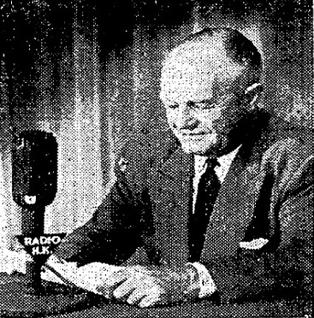
David James Masterton Mackenzie was a British colonial medical official. From January 1958 to September 1963, he was Director of Medical and Health Services of Hong Kong, being the last non-Chinese person to hold that post, and an official member of the Legislative Council.

Nagoya City University West Medical Center is a general hospital located in Kita-ku, Nagoya, Japan, which is administered by the City of Nagoya. This hospital was established in May 2011, from the merger of two hospitals, Nagoya City Jouhoku Hospital and Nagoya City Jousai Hospital.
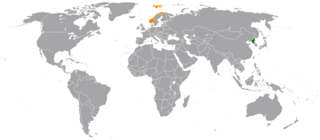
North Korea–Norway relations refers to the current and historical relationship between Norway and the Democratic People's Republic of Korea (DPRK), commonly known as North Korea. Neither country maintains an embassy in the other, although North Korea formerly had an embassy in the Norwegian capital Oslo. The Norwegian ambassador in Seoul is also accredited to North Korea, as is the North Korean one in Stockholm to Norway.
Sze-Piao Yang, also spelled as Sibiao Yang, was a Taiwanese physician and pulmonologist who focused on treating tuberculosis and related lung diseases. He acted as the dean of the affiliated hospital of the National Taiwan University Hospital from 1978 to 1984. He then served concurrently as the dean of National Taiwan University School of Medicine from 1983 to 1985, and also as president of the Tzu Chi University of Science and Technology. He is referred to as the "Father of Thoracic X-ray Interpretation in Taiwan" due to his work in establishing the field of research involving X-rays in Taiwan.






